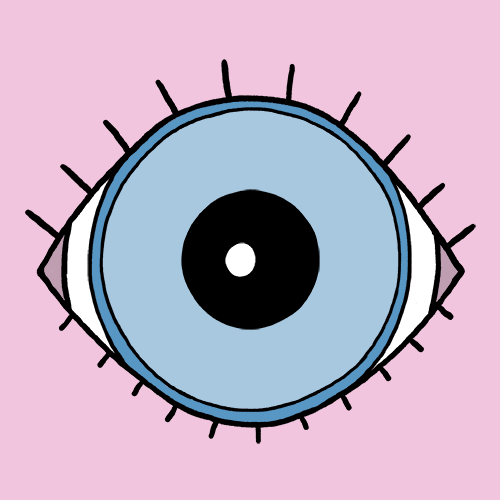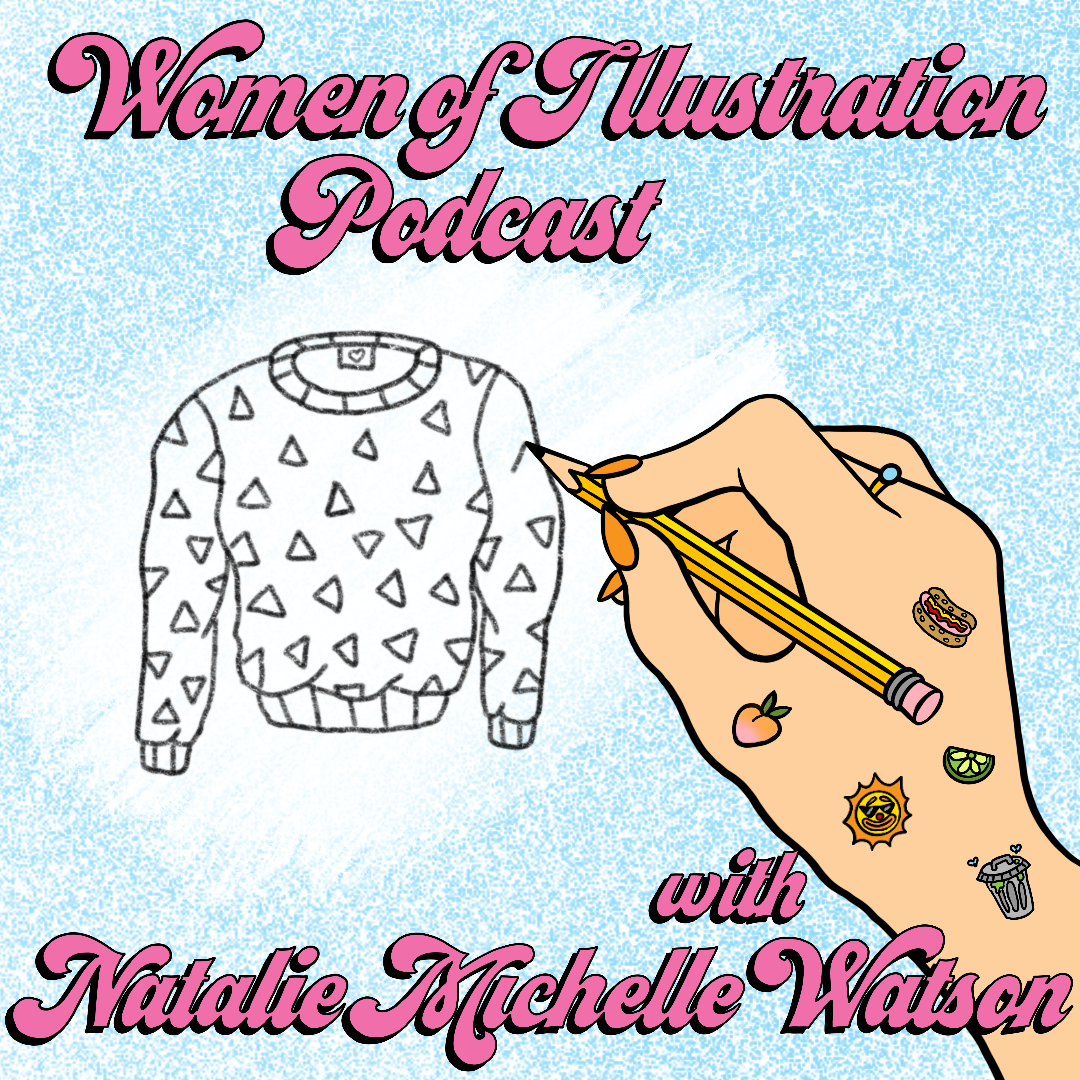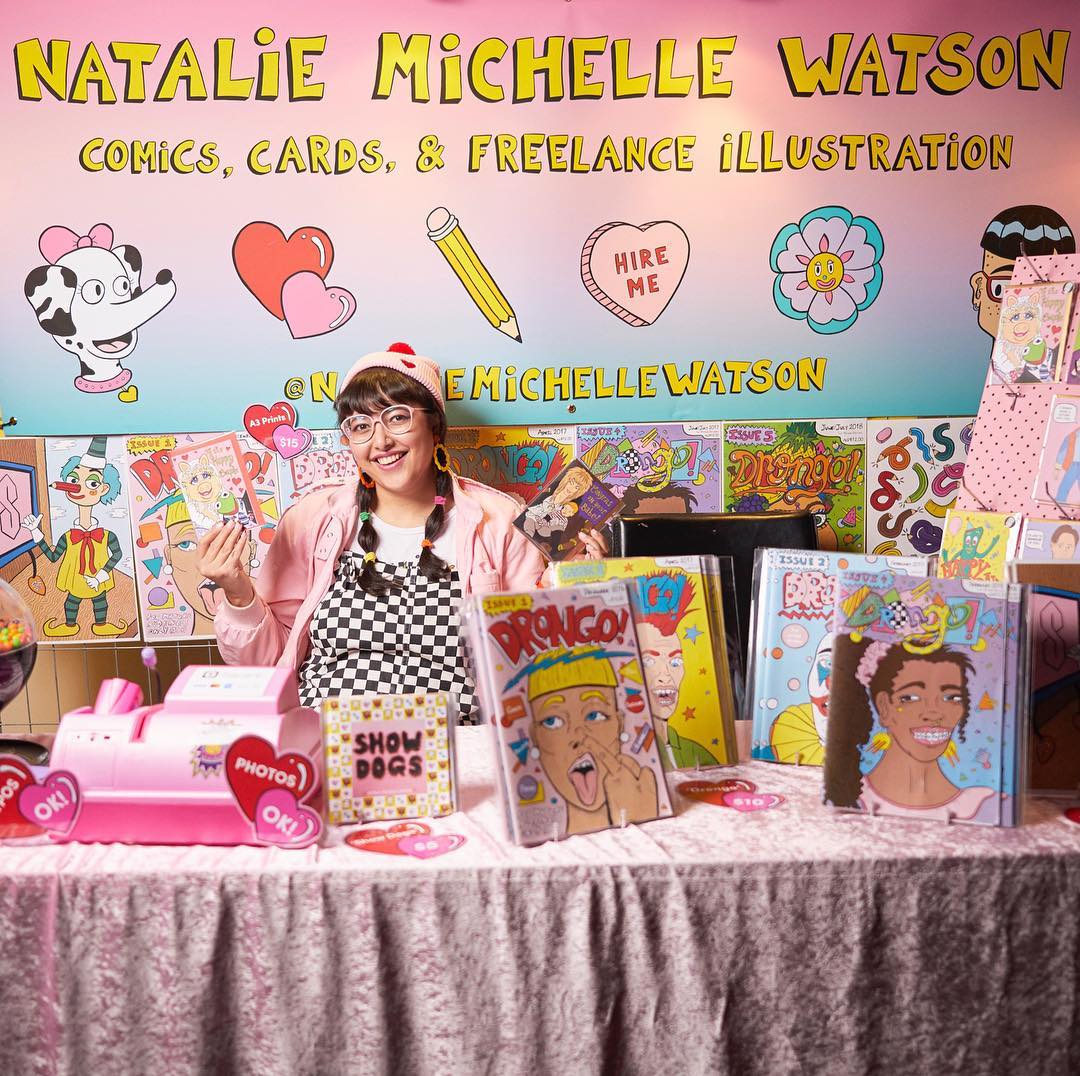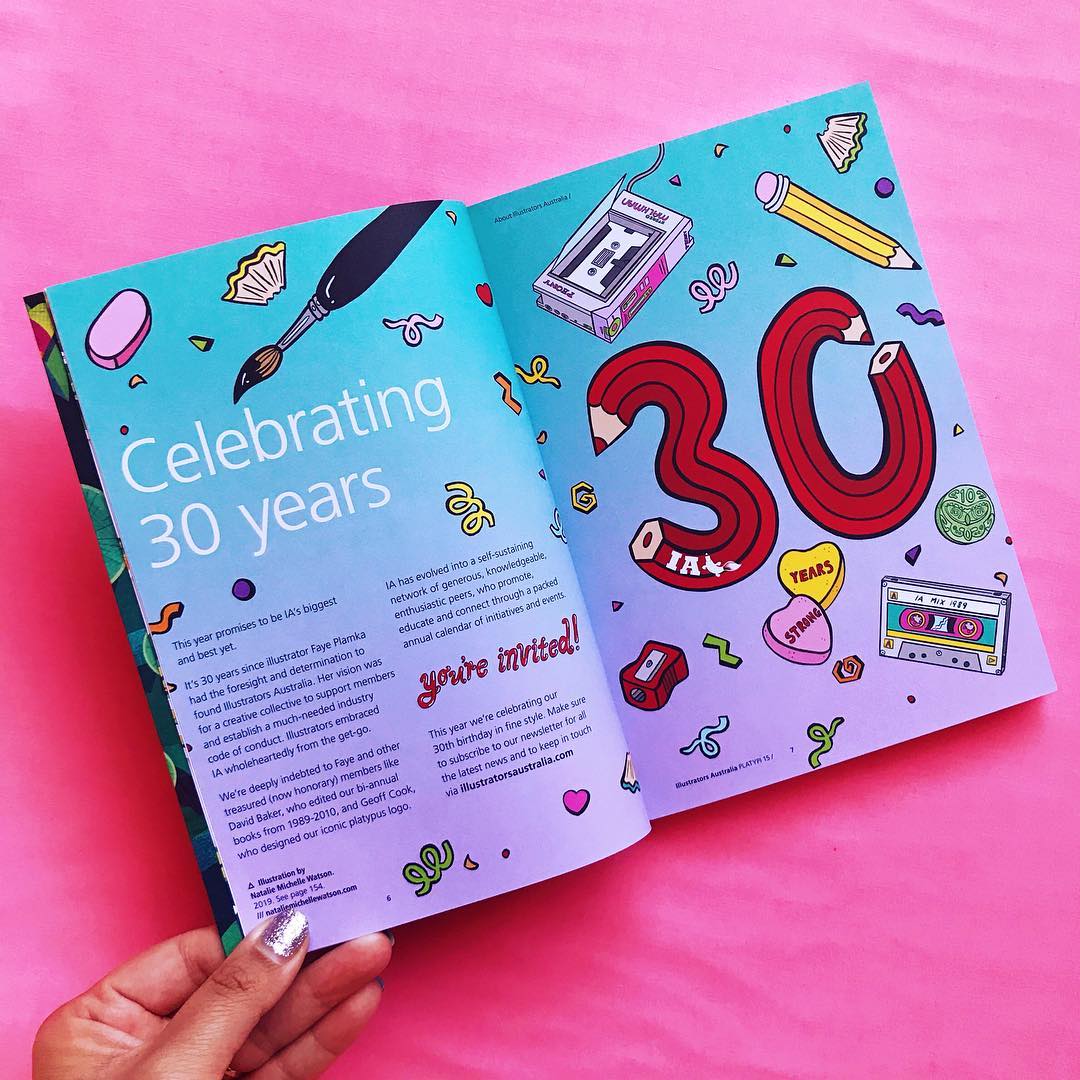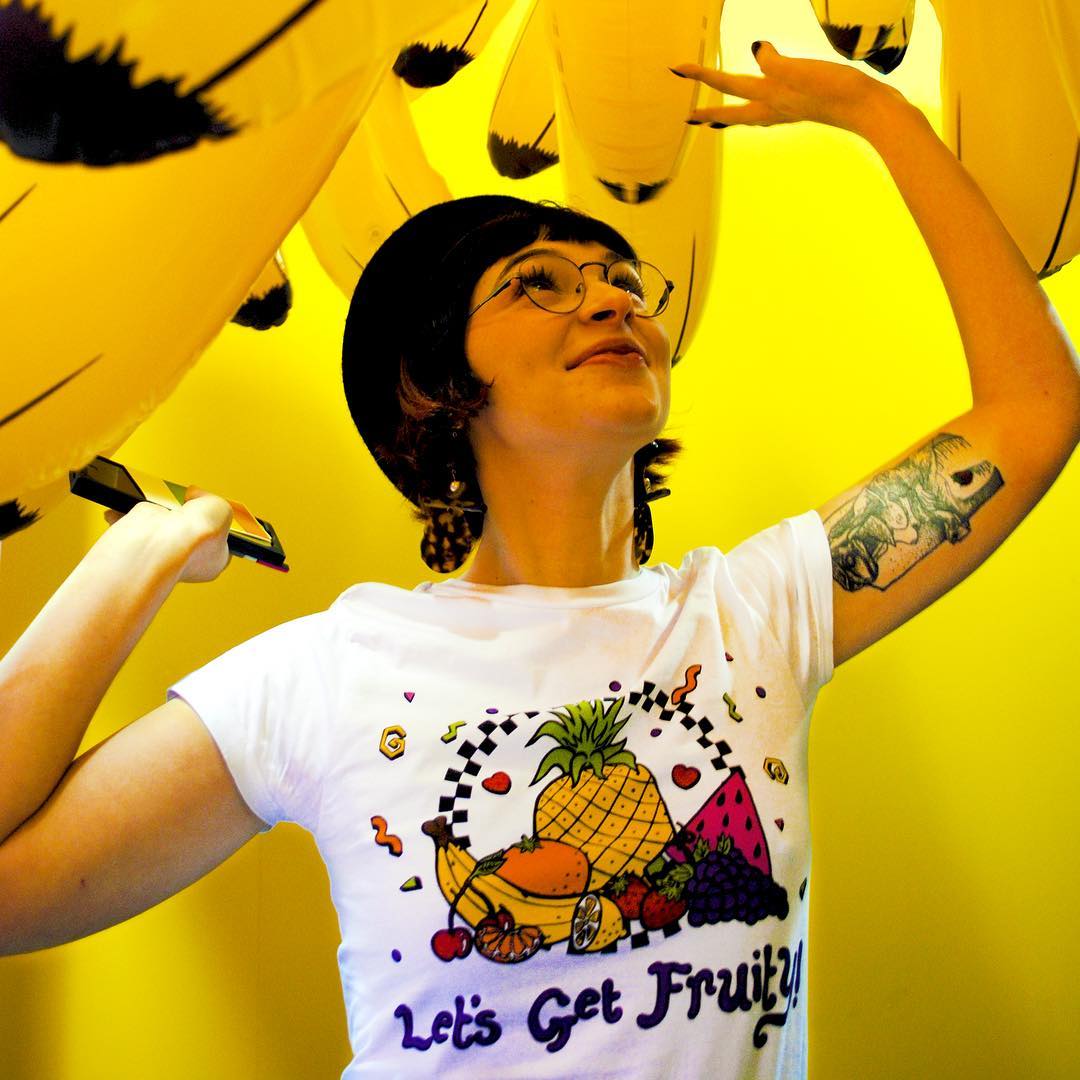Ep 19: The pros and cons of starting your own clothing label with Natalie Michelle Watson
Natalie Watson, fashion designer and illustrator, spills her guts on fashion talking about third party manufacturing, what’s makes a good product, and what she’s learned running several business starting at just 15. Let’s learn from her mistakes, and success stories so we don’t have to learn them the hard way if you are wanting to start your own clothing line.
How would you describe what you do for a living?
Illustrator caught between the throws of 80s-90s nostalgia and a certain ‘fanciness’. Going to reference Moschino here, but something along those lines.
I was so steady with where I stood as an illustrator, and really built up this persona of someone who, pulling from the old kiddy mags in the 90s, started self-publishing “Drongo Magazine” under my own my own label “Drongo Press”.
I recently got married and feel like, as I am giving space to this next step in my life, it’s trickling through into my work. Basically I am still figuring it out. And social media is this portal through which my community is getting to share along in this transition as an artist. Am I doing it right? Is this content still going to resonate? I don’t necessarily know yet.
How do you see this unfolding, what direction do you want to go in
Even just prepping for this episode made me realize how much I missed being in the process of creating my own clothing line. Right now I am looking at how to get back to those roots and combine my illustrations with handmade accessories.
You got your start in fashion, and now you’re working as an illustrator. Tell us what that whole process looked like?
Ok, fifteen-year-old me got my hands on a bag of scrap fabric from my mum’s sewing class and thus, my first creation was conceived, a pencil case. Mind you, I didn’t run with the cool kids, but my homemade pencil case was seemingly ‘with it’ enough to catch the popular girls’ eyes, and the next thing you know I am bringing in $10 a case.
I started my first real business when I was sixteen, coined “Soop Jewelry”, which for a while led to quite a bit of media coverage, though I quickly transitioned into producing my own clothing line around the age of nineteen. 50s ball gowns was my thing. Plus youtube didn’t exist back then, so my initial ball gowns weren’t exactly up to par quality-wise.
Fast forward a little, I founded “Tilly Me”, my actual clothing brand; which within a year of its founding saw an upfront investment of $50,000 dollars. Major residual regrets over that one.
With these experiences serving as your foundation, how do you know when a product is right with regards to your customer basis?
Funny you should ask this. I actually made a list on my top tips for making products, and number one, only make things that you yourself would buy. And don’t get me wrong, testing your market via platforms such as Society6 and Redbubble are an integral factor in feeling out your audience; which personally, isn’t something I’ve done yet. I’d say not knowing my customer and jumping the gun on a lot of things has been my biggest issue, so take it from me!
There’s got to be a balance between on both ends of the spectrum, you as the creator, and the audience you’re catering towards.
Where do you see this next fashion venture going?
This time around I am really going to get a handle on who my audience is before I put anything down on paper, or fabric in this case. For example, I think I really missed the mark with Myspace back in the day. It didn’t really matter whether you knew someone or not, amassing that “friend” count was the only thing of significance. So maybe having gone through a platform such as Myspace would have been a way to better judge my consumer basis and connect with them.
Not that we’ve changed that much in valuing social status, but you definitely can’t just go about friend requesting people anymore. So what I do is I’ll peruse the facebook communities of fellow artists I admire, and see what kinds of people they’re drawing in and resonating with. If I find profiles of individuals whom I think would vibe with what I am doing, I friend request; but obviously explain a as to why I did so. It’s not everyone’s cup of tea, but most people are totally down to network in this way.
So a whole lot of trolling and a little bit of cold emailing, I am just repurposing it for facebook!
As you head into this new era of success, let’s reminisce on some of your failures and how they’ve contributed to how you approach things differently today?
I was solely creating products with other people in mind, and that was the problem, I wasn’t a part of my own demographic. I was listening too much to all the external noise and was trying to gratify the demand in that way.
I’ve had a few major flops, but I have to say my crowning glory’s got to be my tendency for weird creative projects which totally don’t correlate with one another in terms of brand consistency. So I thought it’d be cool to run my own line of bottled water and hand them out at markets, or the time I bottled my own SPF to give out at the beach. And I made these products under my former clothing line “Tilly Me”. There was no branding architecture or brand attributes to help establish and relay to the customer what my brand was all about. They were literally just a random array of enterprises; not to mention the lawsuits my SPF stint could have caused!
What’s your take on influencer marketing?
When I was producing my clothing line, it was all locally manufactured, which is pricey when you compare that to offshore manufacturing. Unfortunately, ethicality and sustainability weren’t as widely discussed as they are now, so people didn’t really care, or were prepared to pay for all that that price tag stood for.
So when it came to influencer marketing, I was actually being approached by a number of people pitching the prospect of a partnership, but that in return for their product placement I’d have to provide them with my products free of charge. Financially, I wasn’t in a position to be able to do that at the time, however, over the years I did manage to build a solid foundation of influencers promoting my line.
I didn’t really see this translate into dollars per se, but it was cool to see my designs being worn by someone of a certain status. I don’t think I properly navigated the dynamics of the influencer partnership and the extent of what that could mean for a brand if done properly. I’d still look to this form of marketing as a viable option today.
I’ve been on both ends of the spectrum, first as the influencer, and then as the brand.
Using Tribe, I’ve done about 15-20 campaigns so far where I really targeted niches outside of the “artist” realm. So this looked like working with influencers who were tapped into the screen time of the everyday person but more so aligned with my aesthetic; plus-size women, people who would want a piece of my art hanging on their walls, but weren’t afraid of a curse word here and there.etc., I invested around $3000 and didn’t see this yield much result in terms of return on investment and engagement.
And I proofread the captions, all content was scheduled for said individuals peak engagement period, the hashtags were good to go; I followed the formula. But I think where I went wrong was that it wasn’t being presented in an authentic way, and it was obvious. Influencer marketing can and will work, after the fact.
That’s exactly what I am struggling with right now. Going back to my style, and it reflecting this current metamorphosis I am going through, my audience is seeing that I am uncomfortable and uncertain with where I am headed. And in this searching, I am trying to find authenticity, but I don’t know what that looks like for myself yet.
And I don’t think your investment of these campaigns can be entirely written off as a waste. Now that you do find that you’re operating from a place of genuinely and the business is reflecting this, customers may scroll back through your feed and feel there’s a certain credibility to the product seeing as you’ve already undergone various partnerships with these authoritative and like minded individuals; though it may not have translated at the time.
So now that we’ve covered the “don'ts”, what do you think are the best ways to launch and advertise a product?
Really milk the release of your product. Hit the socials with sneak previews, behind the scenes, maybe some video content here and there, but all with the goal of hyping the product up. Then, and only then, do you release it.
Creating a sense of “FOMO” is what we’re aiming for!
We want to hit that perfect balance of there being a certain “exclusiveness” to the product, therefore creating that demand, but also making sure we’re including the customer in the process so as to not alienate them. Ask for feedback, maybe put a few polls out there including them in some of the design aspects; involve them.
Also, just opening up about this process will also allow so much more transparency in terms of “Value for Money” (VFM). People aren’t always aware of what the creative production process entails when it comes to this craft, or any craft for that matter.
Exactly! Not everything is as simple as pencil, pen, and paper. If you’re using specific techniques or materials, that’s only going to add to the value of said piece, so educate your consumer basis on the craft and the eventual product they’re investing in.
What’s been your most successful project?
So not all creations under “Tilly me” were as random as the water bottles or SPF. I released a limited-edition line of triangle sweatshirts and they sold out pretty fast; and this was before triangles were a trend!
Another bestseller was my “Beauty Queen” design, which I think just really speaks to us girls, and how we connect with that phrase.
It’s hard to imagine this now, but at the time, triangle sweatshirts weren’t anywhere, they hadn’t become a thing yet. So I think in a sense I hit the mark with being able to provide something unique, but not overly weird.
And, like I said, “Beauty Queen” is a term we can all relate to in one way or another. My design may have leaned a little more towards the girlier side of things. So to all those girls out there who love to primp and preen, that one was for you!
What’s your biggest struggle when making products?
Shipping and fulfillment can be a major downer when you’re bogged under a load of orders, or are dealing with an upset customer, but the thing that gets me the most is finding out that what I want to make can’t actually be done. As in I can’t quite afford the cost of that hefty machinery to get these exact printing nuances. Basically, anything outside of my control irks me.
Relying on other manufacturers, especially when they botch up thousands of dollars worth of fabric (yeah I’ve been there) is such a con for me. My experience thus far has just left me feeling like there’s such a lack of expertise or protocol in the western world in terms of production as we’ve come to rely so heavily on offshore manufacturing.
What were and are some of the resources you’ve found valuable in helping you figure all this out?
Having a mentor you can turn to as a sound-board is an integral part of the process. Don’t discount community and conversing about where you want to take said endeavor of yours’, but having at least someone with an authoritative voice on the industry and subject matters you’re focusing on is key. You don’t want to get lost in your own head. I came across Mercedes Gonzalez of Global Purchasing Companies and her youtube channel; already having spent several years trying to establish my fashion brand at this point. Her video on “Starting a Fashion Line on a Shoestring Budget” hit home and I immediately set up a consultation with her. She served as someone with whom I could just bounce all my ideas and plans off of. Receiving a professional’s constructive feedback is key in moving forwards, and leaves you feeling that bit more empowered with where you stand. And if setting up a consultation isn’t something your budget can cover right now, her latest book “Chronicles of a Fashion Buyer” was also just released!
I am also currently I am taking a course at Coursera offered by Bocconi University, and it’s about the management of fashion and luxury companies if anyone’s interested!
Need some advice? Get a mentor!
I think mentors are such an untapped resource! Even if you’re looking at professionals who aren’t offering their services in this way, you can always email, DM.etc., and request if they’d be willing to offer some feedback or even jump on a consultation call as long as you’re able to compensate them for their time and be respectful towards them in this way. You already have a no, so there’s no harm in asking. Cold emailing and respect can go a long way.
So have you got anything in the works that we can help promote?
I am releasing an ebook all about my top ten tips when starting a fashion brand. You can grab it here.
